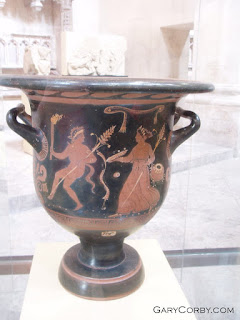These are some of my photos from the Musee Lapidaire in Avignon. The picture quality is not good due to glass cabinets and reflections therein; hopefully I'll have better by the time I'm finished in the Louvre and British Museum.

A reconstructed funerary jar.
Take one corpse, roast over a burning pyre until thoroughly overdone. Douse flames with ritual wine. (This must all be done after dusk so as not to offend the Sun God Apollo with the sight of a dead man).
Scoop up ashes with a hand trowel and pour into this jar.
Set up jar in nearby cemetary. The cemetary just outside the Dipylon Gates to the NW of Athens would be traditional.
Return to visit regularly leaving offerings for the dead. This was a prime duty of all children.
The pigtails in the background btw belong to my younger daughter Megan, who was so very patient while Daddy obsessed about old pots.

A very cool cup.
I expect this would have been a symposium (dinner party) cup.
It's about a hundred years or more after the period I'm writing, maybe about the time of Alexander, hence the more complex decoration with the white coloring. In Nicolaos' time, the latest trendy stuff was all red-figure.

Just to prove I can't hold a camera straight, here is a krater. They were used to mix wine at symposia, which were fun dinner parties, not boring academic waffling.
Only a barbarian would drink wine neat. Greeks always mixed wine with water, which would be the duty of slave boys.
The symposiarch, the guy in charge of festivities, would decide the ratio. 3 water for 1 wine meant a pleasant evening of refined philosophical discussion. 2 for 1 was party time. 1 for 1 meant the flute girls could expect extra pay for extra duties.

This is a hydria, as the name implies used for storing water, or sometimes oil.
You'd find lots of these in every kitchen and bar.

No comments:
Post a Comment